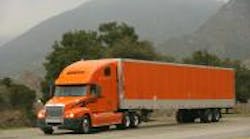“What gets measured gets improved.” –Robin S. Sharma, author of The Greatness Guide: Powerful Secrets for Getting to World Class
It’s a well-known axiom in trucking that everything needs to get tested, for that’s how one confirms whether or not the item in question – be it an engine, tire, suspension, entire trailer, whatever – delivers on its promise.
Maybe you’re expecting better fuel economy, or better vehicle handling for your drivers. Maybe you want more load-carrying capacity out of your trailers, or improve ease of maintenance for your technicians. The only way to do any of that, of course, is to test out the new products you’re considering, to see if they meet those expectations.
TL carrier Schneider National figured this out a while ago – back in 1989, actually – and has spent the last 22 years honing its in-house testing program to help it gain every ounce of advance possible from its equipment.
Steve Graham (seen below) got the ball rolling (so to speak) back then when, as Schneider’s tire program manager, he realized fuel economy should factor heavily in tire purchasing decisions, thus leading him to study how to test various tires for fuel efficiency.
As a result, he traveled to the Transportation Research Center in Ohio, where many OEMs – automotive and truck makers alike – conduct vehicle testing on a variety of test tracks. Graham said he watched tire makers conduct Society of Automotive Engineering (SAE) fuel economy tests on their products, and that’s when a light bulb when off in his head.
Perhaps Schneider could adapt the very same scientific and methodical practices outlined in these SAE protocols, he thought – practices designed to eliminate the influence of variables – helping the fleet evaluate the efficiency and performance of its own equipment in-house, he thought. The rest, as they say, is history.
[To view a photo gallery of Schneider's testing efforts, click here.]
“Our testing program started quite primitively,” said Graham, now VP of purchasing for Schneider. “But while today’s program is much more sophisticated, the goal is the same now as it was back then: find new ways to minimize fuel usage and reduce our environmental impact.”
Today, Schneider employs an on-site team of engineers who work year round on a wide range of equipment-research needs for the company, including process development, maintenance training, troubleshooting equipment and component testing.
Come summertime, however, they gear up to conduct SAE Type II and Type III on-highway fuel economy testing on new truck and trailer models that will be joining the fleet.
Though the number of technologies and/or products tested each year can range from 10 to 40, Graham explained, they are all tested in the same controlled manner on a 50-mile route in Northeast Wisconsin that recreates the typical engine stress loads experienced by Schneider’s fleet.
Two trucks are pulled from the fleet for the summer so they can be dedicated solely to testing, along with two veteran drivers with extensive experience in these efforts. In each test, one truck becomes the “control” vehicle, while the other is outfitted with the technology and/or product being evaluated.
Graham said Schneider has made big invests in high-quality scaling equipment, since fuel is weighed before and after each trial to determine the efficiency of the trip, as well a large tank positioned at the testing site so that the same batch of fuel can be used in each test. Both trucks travel the predetermined route, accelerate in the same manner, idle the same amount of time and stop in the same places, he said.
“We rely on experienced drivers to help us determine which runs are successful and which need to be thrown out,” he noted. “For example, if one of our trucks is passed by another truck carrying a heavy load that causes a gust of wind as it moves ahead of our truck, our drivers know to tell us that this particular trial is invalid.”
Routes are run as many times as needed until the team is confident in its results, which are analyzed at the test site in a special trailer the company purchased and converted into a command center.
“We actually hold ourselves to a tighter standard than SAE protocol requires to determine even the smallest variances,” Graham said. “Even if a device yields less than 1% fuel efficiency, that small amount of savings can add up to huge numbers when you consider the vast size of our fleet.”
Case in point: In 2010, Schneider added “Deflecktor” aerodynamic wheel covers to its trucks after extensive SAE testing, he noted. The device delivers 0.8% fuel efficiency, which translates into 1.8 million gallons of fuel conserved each year on Schneider’s trucks. With diesel fuel at almost $4 a gallon on average in the U.S., that translates into a savings of about $7.2 million – definitely not chump change.
On Schneider’s list for testing this year between June and August are a host of new items, including: low viscosity motor oils; renewable fuel alternatives; low-rolling resistance tires; new engine calibrations; predictive cruise control, in which the engine uses mapping software to determine how to best conserve vehicle momentum when approaching or cresting hills; and verification of Freightliner tractor wind tunnel testing.
None of this testing comes cheap of course. But, again, with the cost of diesel fuel now up around $4 a gallon on average in the U.S. – and nearing $5 in California – such rigorous testing can pay big dividends over the long haul.







